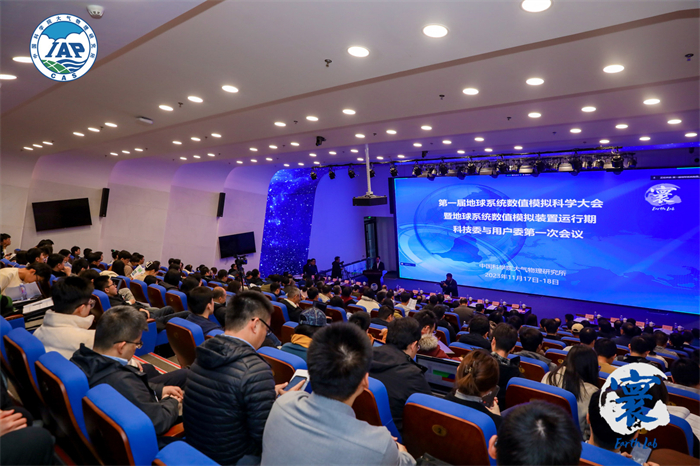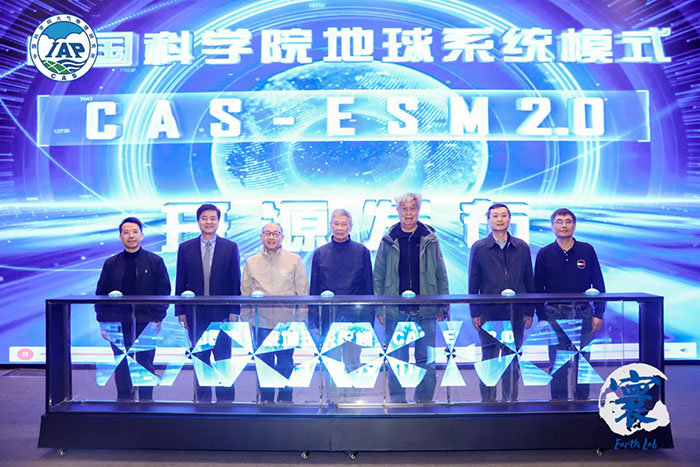The First "Earth System Numerical Simulation Science Conference" and the Inaugural Meeting of the "EarthLab Science and Technology Committee and User Committee" were successfully held in Beijing's Miyun from November 17th to 18th, 2023.
The conference witnessed the participation of over 300 individuals from more than 50 institutions, including universities, research institutes, relevant industry departments, and government bodies.
The opening ceremony, chaired by Academician Dai Yongjiu, commenced with Dr. Zeng Qingcun expressing gratitude for the substantial support and assistance from various entities such as the Ministry of Science and Technology, the National Natural Science Foundation of China, the Chinese Academy of Sciences, and the Beijing Municipal Government. Dr. Zeng highlighted the complex and challenging nature of developing both the CAS Earth System Model (ESM) and the Earth System Numerical Simulation Device. He emphasized the continued enthusiasm and confidence of the team, spanning decades of dedication, from the initial ambition of developing China's ESM to today's CAS-ESM being recognized as one of the world's premier models. The release of CAS-ESM to the nation and the world marks a pivotal step in advancing Chinese Earth System Science, promoting open collaboration, and harnessing advanced methodologies to strengthen the model's efficacy.
The unveiling of China's first independently developed "complete" Earth System Model, CAS-ESM 2.0, along with the announcement of its source code release, signifies a new era of collaborative development and mutually beneficial cooperation in China's Earth System Model advancement.
Dr. Cao Junji, Director of the Institute of Atmospheric Physics at the Chinese Academy of Sciences, provided an overview of the CAS-ESM's developmental journey, subsystem model features, comparative performance across different versions, and its significant accomplishments. Dr. Cao concluded by outlining the open-sharing mechanism for the large device and its future developmental trajectory.
The CAS-ESM, integrating eight subsystem models covering the climate and ecological systems, facilitates material and energy exchanges among the Earth's layers through a coupler. This comprehensive model system, based on numerical simulation, enables the exploration of climate and environmental evolution patterns, the study of multi-layer interaction mechanisms, prediction of future Earth system changes, and provides decision-making support and technological backing for national disaster prevention, mitigation, and addressing future climate change.
CAS-ESM2.0, was jointly developed by top domestic teams across Earth Sciences, Mathematics, and Computational Science. It comprises approximately 2.7 million lines of code, hailed as an “Earth Laboratory”, or "EarthLab." Its simulation performance in indicators like tropical wind fields, Atlantic Meridional Overturning Circulation, and El Ni?o-Southern Oscillation has ranked among the world's best in the Sixth Phase of the Coupled Model Intercomparison Project (CMIP6) since 2020.
Leveraging the EarthLab, the Institute of Atmospheric Physics established the "Earth System Numerical Simulation Device Science Center," focusing on research and support, interdisciplinary innovation, model development, application output, transformation, and maintenance of the device, serving the national economy and society. The inauguration of the center was officiated by Dr. Zeng Qingcun, Dr. Ma Xinming, Academician Dai Yongjiu, Dr. Zhang Chaolin, Dr. Ren Xiaobo, and Dr. Cao Junji.

The plenary session included invited reports from experts, such as Dr. Dai Yongjiu, Dr. Shi Yaolin, Dr. Song Junqiang, Dr. Zheng Xiaojing, Dr. Wang Chi, Dr. Chai Fei, and Dr. Zheng Fei. They presented the latest advancements and future trends in diverse areas, including Universal Land Surface Models (CoLM), Solid Earth Dynamics Computing in Earth System Dynamics, Earth System Digital Twins and Applications of Artificial Intelligence, Global Carbon Cycle Simulation and Regulation Research, Multiscale and Cross-scale Analysis in Wind and Sand Processes, Progress in Space Weather Model Research, Methods and Models of Marine Ecosystems and Ocean Carbon Sinks, Progress in Earth System Coupled Data Assimilation Research, and Applications in CAS-ESM.

The inaugural meeting of the EarthLab Science and Technology Committee and EarthLab User Committee was held in the evening of November 17th, chaired by Dr. Cao Junji. Dr. Zeng Xiaodong, Deputy Director of the newly established Earth System Numerical Simulation Device Science Center, reported on the operational status of the EarthLab in 2022-2023, its operational plan for 2024, and the open-sharing mechanism. The committee members discussed key points for the EarthLab's future development and provided suggestions, believing that under the guidance of the committees, the device will elevate its international influence, better serve the country's major strategic needs, and address significant scientific challenges.
On November 18th, the scientific conference comprised thematic sessions encompassing Earth System Theory and Model Development, Earth System Prediction and Data Assimilation, Earth System Numerical Simulation and Global Change, Regional Environmental Change and Regulation, Algorithms and High-Performance Computing in Earth System Numerical Simulation, among others, totaling 83 oral presentations. Experts exchanged insights on the latest research progress in CAS-ESM and other Earth System Numerical Models, discussing future developmental directions, fostering collaborative research, and exploring potential cooperation avenues.
The event was organized by the Bureau of Science and Technology Promotion Development of the Chinese Academy of Sciences, hosted by the Institute of Atmospheric Physics at the Chinese Academy of Sciences, and co-organized by Tsinghua University, China Meteorological Administration Earth System Numerical Prediction Center, CAS-TWAS-WMO Forum, Beijing Miyun District People's Government, Beijing Huairou Science City Management Committee, and the Taoshiyan Foundation.
This conference brought together researchers, engineers, and application developers from various fields to exchange cutting-edge research progress, advanced technologies, and application cases in Earth System Simulation and Application Science. It aimed to explore the development direction of Earth System Simulation and Application Science, meet the country's major needs, and promote China's Earth System Science to an internationally leading level. With the release of CAS-ESM and the establishment of the Science Center, it aspires to establish an integrated R&D platform for interdisciplinary research encompassing Earth Sciences, High-Performance Computing, Big Data, Artificial Intelligence, and foster an open atmosphere for Earth System Science research and innovation.




